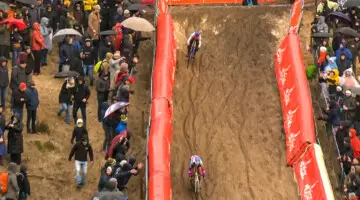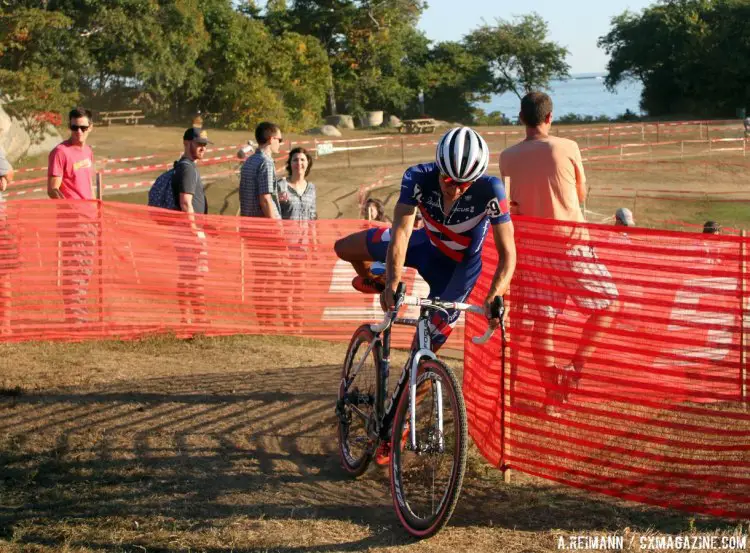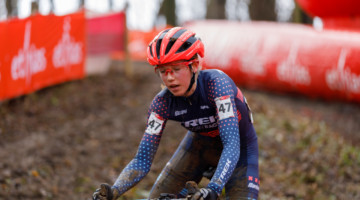This weekend, Colin Reuter of crossresults.com poured over his databases with one goal in mind: to figure out the best and worst ways to try and get a UCI point in cyclocross in the United States.
How did he do this? He looked at all the races on the USA CX Pro Calendar, and based on his crossresults.com rider points system, he examined both the predicted rider and the actual rider to claim the last UCI point in a given race.
For the full math and his conclusions, be sure to check out his post at Until the Snow Ends, but we wanted to offer some of his salient points, as well as make a few of our own.
Only Care about UCI Points? Don’t Be Lured in by the C1 Race Weekends
Besides a bigger payout, C1 races offer UCI points to five more riders than C2 races. At a quick glance, a rider might think this gives them a better chance at swiping up a UCI point or two. But as Reuter points out, this is the worst approach, mainly due to riders only being allowed to get UCI points from their top five results per year.
“There’s only seven C1 races in the country, but there’s 37 C2s,” he writes. “So if [top level racers] race a lot of UCI races, it doesn’t take long to have five good C2 results on [their] record, after which C2s stop being very attractive to race in. Meanwhile with a maximum of seven chances at your six C1 scores, every C1 ‘counts.'”
With a barrage of Europeans arriving to CrossVegas this year, it was predicted in both fields to be the most difficult race, although the actual toughest race for women turned out to be the Pan-American Cincy C1 race. The easiest C1 weekend? The Trek CXC Cup.
While there are a few exceptions that surprised us, such as Full Moon Vista and Jingle Cross in the men’s field, some of the toughest races of the year come during the C2 day of the C1 weekend, where the competition remains similar but the available points are diminished.
The real takeaway here is targeting C2 weekends, though. Rapha Super Cross Gloucester, which sits on the first weekend of New England’s Holy Week, is the big exception, and acts more like a C1 race weekend with the high level of competition brought to the course.
Only Care about UCI Points? Move to the Northeast
For the last few years, Elite racers have known that the Kingsport Cyclo-cross Cup is the race to score a UCI point at, and Reuter only cements this anecdotal piece of advice with data. CXLA isn’t a bad race either to try and score a point or two.
Since most of us don’t have indispensable travel miles, however, Reuter points out that the sheer number of C2 races makes New England and the Mid-Atlantic a very attractive place to race cyclocross for UCI points. Riders based in Los Angeles or Tennessee might curse their luck a little more if they happen to double up on mechanicals for their race weekend, while Northeast racers get plenty more opportunities to recover from mistakes or misfortune.
Only Care about UCI Points? Men Shouldn’t Peak in September, but Women Could Consider It
When we looked at Reuter’s graphs, we noticed one big difference between men and women in C2 races: During the season, the Elite Men come hot out of the gates, and the September C2 weekends of 2014, such as Charm City, Nittany Lion and Rapha Super Cross Gloucester are some of the most difficult of the year to get a UCI point in.
Elite Women, on the other hand, are not as fair weather. When the temperature drops, high level participation and competition rise at C2 races.
What’s the takeaway? If getting a UCI point is your one and only concern, targeting the season while your competition is putting their feet up might be worthwhile. Still, no matter what field you ride in, peaking as a September rider will cost you big later in the season.
Only Care about UCI Points? Find a Way to Get in a World Cup
We took Reuter’s approach to UCI point hunting and applied it to the world stage, wondering where the international UCI point snipers stood out. The answer, of course, is at World Cup events.
In the last three World Cup events, the last place to get UCI points would not have gotten UCI points at the vast majority of American races according to their CrossResults ranking (Kingsport is the consistent exception to this).
Theoretically speaking, however, this is a foolish way to look at it since every Elite rider who doesn’t pull themselves from a World Cup race automatically takes home a whopping five UCI points. In other words, if your Great-Aunt Vivian is living under the right cycling federation, she could walk away with UCI points as long as she doesn’t break her hip descending in Namur.
The second problem with our analysis is that although CrossResults has an impressive number of European results, the site doesn’t exactly have a full compliment of Australian and Spanish cyclocross races to give a few of the bottom riders a more accurate ranking. Nonetheless, Reuter’s separate graphs including the World Cups would look accurately comical since it takes a practical legend to make the top ten prediction at a World Cup, but any participant can walk away with points.
Also, because UCI points at World Cup events don’t interfere with other points obtained from C1 and C2 events, they are truly points that keep on giving.
The challenge is convincing your cycling federation to send you to a World Cup event in the first place, which will become all the more difficult for North Americans now that stages are coming to CrossVegas and Montreal.
Only Care about UCI Points? Shame on You!
Most of us don’t even have to worry about tire size or UCI call-ups. But even if you are an Elite rider, it would be a shame to miss out participating in great races such as Rapha Super Cross Gloucester or Derby City because they offer a more challenging road to qualifying for Nationals.



























